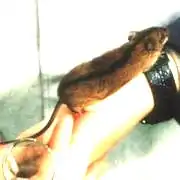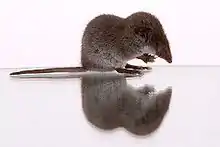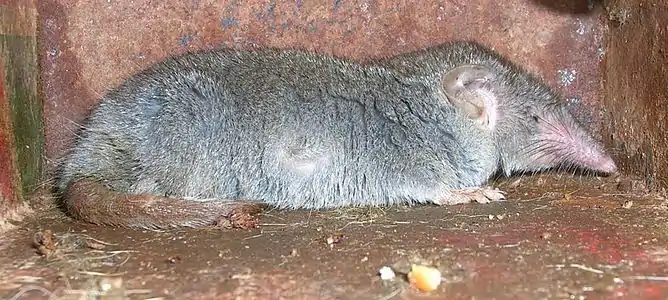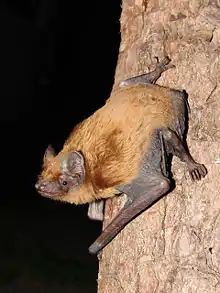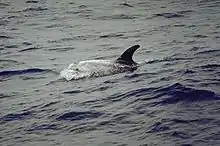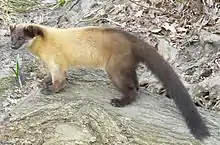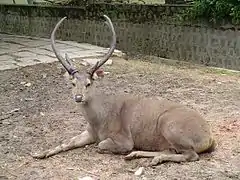List of mammals of Taiwan
This is a list of the mammal species recorded in Taiwan. There are 122 mammal species in Taiwan, of which five are endangered, eight are vulnerable and two are near threatened.[1]
The following tags are used to highlight each species' conservation status as assessed by the International Union for Conservation of Nature:
| EX | Extinct | No reasonable doubt that the last individual has died. |
| EW | Extinct in the wild | Known only to survive in captivity or as a naturalized populations well outside its previous range. |
| CR | Critically endangered | The species is in imminent risk of extinction in the wild. |
| EN | Endangered | The species is facing an extremely high risk of extinction in the wild. |
| VU | Vulnerable | The species is facing a high risk of extinction in the wild. |
| NT | Near threatened | The species does not meet any of the criteria that would categorise it as risking extinction but it is likely to do so in the future. |
| LC | Least concern | There are no current identifiable risks to the species. |
| DD | Data deficient | There is inadequate information to make an assessment of the risks to this species. |
Order: Primates
The order Primates contains humans and their closest relatives: lemurs, lorisoids, monkeys, and apes.
- Suborder: Haplorhini
- Infraorder: Simiiformes
- Parvorder: Catarrhini
- Superfamily: Cercopithecoidea
- Family: Cercopithecidae (Old World monkeys)
- Genus: Macaca
- Formosan rock macaque, M. cyclopis VU
- Genus: Macaca
- Family: Cercopithecidae (Old World monkeys)
- Superfamily: Cercopithecoidea
- Parvorder: Catarrhini
- Infraorder: Simiiformes
Order: Rodentia (rodents)
Rodents make up the largest order of mammals, with over 40% of mammalian species. They have two incisors in the upper and lower jaw which grow continually and must be kept short by gnawing. Most rodents are small though the capybara can weigh up to 45 kg (99 lb).
- Suborder: Sciurognathi
- Family: Sciuridae (squirrels)
- Subfamily: Sciurinae
- Tribe: Pteromyini
- Genus: Belomys
- Hairy-footed flying squirrel, Belomys pearsonii NT
- Genus: Petaurista
- Red and white giant flying squirrel, Petaurista alborufus LC
- Indian giant flying squirrel, Petaurista philippensis LC
- Genus: Belomys
- Tribe: Pteromyini
- Subfamily: Callosciurinae
- Genus: Callosciurus
- Pallas's squirrel, Callosciurus erythraeus LC
- Genus: Dremomys
- Perny's long-nosed squirrel, Dremomys pernyi LC
- Genus: Tamiops
- Maritime striped squirrel, Tamiops maritimus LC
- Genus: Callosciurus
- Subfamily: Sciurinae
- Family: Cricetidae
- Subfamily: Arvicolinae
- Genus: Eothenomys
- Père David's vole, Eothenomys melanogaster LC
- Genus: Volemys
- Taiwan vole, Volemys kikuchii VU
- Genus: Eothenomys
- Subfamily: Arvicolinae
- Family: Muridae (mice, rats, voles, gerbils, hamsters, etc.)
- Subfamily: Murinae
- Genus: Apodemus
- Striped field mouse, Apodemus agrarius LC
- Taiwan field mouse, Apodemus semotus NT
- Genus: Bandicota
- Greater bandicoot rat, Bandicota indica LC
- Genus: Micromys
- Harvest mouse, Micromys minutus NT
- Genus: Mus
- Ryukyu mouse, Mus caroli LC
- Genus: Niviventer
- Coxing's white-bellied rat, Niviventer coxingi NT
- Oldfield white-bellied rat, Niviventer culturatus NT
- Genus: Rattus
- Lesser ricefield rat, Rattus losea LC
- Tanezumi rat, Rattus tanezumi LC
- Brown rat, Rattus norvegicus LC
- Genus: Apodemus
- Subfamily: Murinae
- Family: Sciuridae (squirrels)
Order: Lagomorpha (lagomorphs)
The lagomorphs comprise two families, Leporidae (hares and rabbits), and Ochotonidae (pikas). Though they can resemble rodents, and were classified as a superfamily in that order until the early 20th century, they have since been considered a separate order. They differ from rodents in a number of physical characteristics, such as having four incisors in the upper jaw rather than two.
- Family: Leporidae (rabbits, hares)
- Genus: Lepus
- Chinese hare, Lepus sinensis LC
- Genus: Lepus
Order: Soricomorpha (shrews, moles, and solenodons)
The soricomorphs are insectivorous mammals. The shrews and solenodons closely resemble mice while the moles are stout-bodied burrowers.
- Family: Soricidae (shrews)
- Subfamily: Crocidurinae
- Genus: Crocidura
- Asian gray shrew, Crocidura attenuata LC
- Taiwanese gray shrew, Crocidura tanakae LC
- Gueldenstaedt's shrew, Crocidura gueldenstaedtii LC
- Horsfield's shrew, Crocidura horsfieldii LC
- Asian lesser white-toothed shrew, Crocidura shantungensis LC
- Genus: Suncus
- Asian house shrew, Suncus murinus LC
- Genus: Crocidura
- Subfamily: Soricinae
- Tribe: Nectogalini
- Genus: Chimarrogale
- Himalayan water shrew, Chimarrogale himalayica LC
- Genus: Soriculus
- Taiwanese brown-toothed shrew, Soriculus fumidus LC
- Genus: Chimarrogale
- Tribe: Nectogalini
- Subfamily: Crocidurinae
- Family: Talpidae (moles)
- Subfamily: Talpinae
- Tribe: Talpini
- Genus: Mogera
- Insular mole, Mogera insularis LC
- Senkaku mole, Mogera uchidai Vu
- Genus: Mogera
- Tribe: Talpini
- Subfamily: Talpinae
Order: Chiroptera (bats)
The bats' most distinguishing feature is that their forelimbs are developed as wings, making them the only mammals capable of flight. Bat species account for about 20% of all mammals.
- Family: Pteropodidae (flying foxes, Old World fruit bats)
- Subfamily: Pteropodinae
- Genus: Pteropus
- Ryukyu flying fox, Pteropus dasymallus EN
- Genus: Pteropus
- Subfamily: Pteropodinae
- Family: Vespertilionidae
- Subfamily: Myotinae
- Genus: Myotis
- Large-footed bat, Myotis adversus LC
- Hodgson's bat, Myotis formosus LC
- Genus: Myotis
- Subfamily: Vespertilioninae
- Genus: Arielulus
- Necklace pipistrelle, Arielulus torquatus DD
- Genus: Eptesicus
- Serotine bat, Eptesicus serotinus LC
- Genus: Nyctalus
- Common noctule, Nyctalus noctula LC
- Genus: Plecotus
- Taiwan big-eared bat, Plecotus taivanus VU
- Genus: Scotophilus
- Lesser Asiatic yellow bat, Scotophilus kuhlii LC
- Genus: Vespertilio
- Asian parti-colored bat, Vespertilio superans LC
- Genus: Arielulus
- Subfamily: Murininae
- Genus: Harpiocephalus
- Hairy-winged bat, Harpiocephalus harpia LC
- Genus: Murina
- Taiwan tube-nosed bat, Murina puta VU
- Genus: Harpiocephalus
- Subfamily: Miniopterinae
- Genus: Miniopterus
- Schreibers' long-fingered bat, Miniopterus schreibersii LC
- Genus: Miniopterus
- Subfamily: Myotinae
- Family: Molossidae
- Genus: Tadarida
- European free-tailed bat, Tadarida teniotis LC
- Genus: Tadarida
- Family: Rhinolophidae
- Subfamily: Rhinolophinae
- Genus: Rhinolophus
- Formosan lesser horseshoe bat, Rhinolophus monoceros NT
- Genus: Rhinolophus
- Subfamily: Hipposiderinae
- Genus: Coelops
- East Asian tailless leaf-nosed bat, Coelops frithii LC
- Genus: Hipposideros
- Great roundleaf bat, Hipposideros armiger LC
- Genus: Coelops
- Subfamily: Rhinolophinae
Order: Pholidota (pangolins)
The order Pholidota comprises the eight species of pangolin. Pangolins are anteaters and have the powerful claws, elongated snout and long tongue seen in the other unrelated anteater species.
- Family: Manidae
- Genus: Manis
- Chinese pangolin, M. pentadactyla CR
- Genus: Manis
Order: Cetacea (whales)
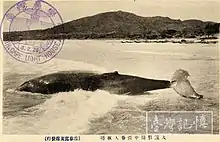
.jpg.webp)

The order Cetacea includes whales, dolphins and porpoises. They are the mammals most fully adapted to aquatic life with a spindle-shaped nearly hairless body, protected by a thick layer of blubber, and forelimbs and tail modified to provide propulsion underwater.
- Suborder: Mysticeti
- Family: Balaenidae
- Genus: Eubalaena
- North Pacific right whale, Eubalaena japonica CR
- Genus: Eubalaena
- Family: Eschrichtiidae
- Genus: Eschrichtius
- Western gray whale, Eschrichtius robustus CR[2][3]
- Genus: Eschrichtius
- Family: Balaenopteridae
- Subfamily: Megapterinae
- Genus: Megaptera
- Northern humpback whale, Megaptera novaeangliae VU
- Genus: Megaptera
- Subfamily: Balaenopterinae
- Genus: Balaenoptera
- Common minke whale, Balaenoptera acutorostrata (Coastal Asia) EN
- Northern sei whale, Balaenoptera borealis (Coastal Asia) CR
- Eden's whale, Balaenoptera edeni (East China Sea) LC
- Blue whale, Balaenoptera musculus
- Northern blue whale, B. m. musculus (Coastal Asia) CR
- Omura's whale, Balaenoptera omurai DD
- Fin whale, Balaenoptera physalus
- Northern fin whale, B. p. physalus (Coastal Asia) CR
- Genus: Balaenoptera
- Subfamily: Megapterinae
- Family: Balaenidae
- Suborder: Odontoceti
- Superfamily: Platanistoidea
- Family: Phocoenidae
- Genus: Neophocaena (finless porpoise)
- Finless porpoise, Neophocaena phocaenoides VU
- Genus: Neophocaena (finless porpoise)
- Family: Ziphidae
- Genus: Ziphius
- Cuvier's beaked whale, Ziphius cavirostris DD
- Subfamily: Hyperoodontinae
- Genus: Indopacetus
- Tropical bottlenose whale, Indopacetus pacificus DD
- Genus: Mesoplodon
- Blainville's beaked whale, Mesoplodon densirostris DD
- Ginkgo-toothed beaked whale, Mesoplodon ginkgodens DD
- Genus: Indopacetus
- Genus: Ziphius
- Family: Delphinidae (marine dolphins)
- Genus: Sousa
- Chinese white dolphin, Sousa chinensis DD
- Genus: Tursiops
- Indo-Pacific bottlenose dolphin, Tursiops aduncus DD
- Common bottlenose dolphin, Tursiops truncatus DD
- Genus: Stenella
- Pantropical spotted dolphin, Stenella attenuata DD
- Striped dolphin, Stenella coeruleoalba LC
- Spinner dolphin, Stenella longirostris DD
- Genus: Delphinus
- Long-beaked common dolphin, Delphinus capensis DD
- Short-beaked common dolphin, Delphinus delphis LC
- Genus: Lagenodelphis
- Fraser's dolphin, Lagenodelphis hosei DD
- Genus: Lagenorhynchus
- Pacific white-sided dolphin, Lagenorhynchus obliquidens LC
- Genus: Grampus
- Risso's dolphin, Grampus griseus DD [4]
- Genus: Feresa
- Pygmy killer whale, Feresa attenuata DD
- Genus: Peponocephala
- Melon-headed whale, Peponocephala electra LC
- Genus: Pseudorca
- False killer whale, Pseudorca crassidens LC
- Genus: Globicephala
- Short-finned pilot whale, Globicephala macrorhynchus DD
- Genus: Orcinus
- Orca, Orcinus orca DD
- Genus: Sousa
- Family: Phocoenidae
- Superfamily: Platanistoidea
Order: Carnivora (carnivorans)
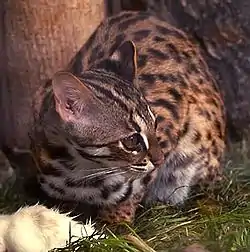
There are over 260 species of carnivorans, the majority of which feed primarily on meat. They have a characteristic skull shape and dentition.
- Suborder: Feliformia
- Family: Felidae (cats)
- Subfamily: Felinae
- Genus: Prionailurus
- Leopard cat, P. bengalensis LC
- Genus: Prionailurus
- Subfamily: Felinae
- Family: Viverridae (civets, genets etc.)
- Subfamily: Paradoxurinae
- Genus: Paguma
- Masked palm civet, P. larvata LC
- Genus: Paguma
- Subfamily: Viverrinae
- Genus: Viverricula
- Small Indian civet, V. indica LC
- Genus: Viverricula
- Subfamily: Paradoxurinae
- Family: Herpestidae (mongooses)
- Genus: Herpestes
- Crab-eating mongoose, H. urva LC
- Genus: Herpestes
- Family: Felidae (cats)
- Suborder: Caniformia
- Family: Ursidae (bears)
- Genus: Ursus
- Asiatic black bear, U. thibetanus VU
- Formosan black bear, U. t. formosanus
- Asiatic black bear, U. thibetanus VU
- Genus: Ursus
- Family: Mustelidae (mustelids)
- Genus: Aonyx
- Asian small-clawed otter, A. cinereus VU
- Genus: Lutra
- European otter, L. lutra NT
- Genus: Martes
- Yellow-throated marten, M. flavigula LC
- Genus: Melogale
- Chinese ferret badger, M. moschata LC
- Genus: Mustela
- Least weasel, M. nivalis LC
- Siberian weasel, M. sibirica LC
- Genus: Aonyx
- Family: Ursidae (bears)
Order: Artiodactyla (even-toed ungulates)
The even-toed ungulates are ungulates whose weight is borne about equally by the third and fourth toes, rather than mostly or entirely by the third as in perissodactyls. There are about 220 artiodactyl species, including many that are of great economic importance to humans.
- Family: Suidae (pigs)
- Family: Cervidae (deer)
- Subfamily: Cervinae
- Genus: Cervus
- Sika deer, C. nippon LC
- Formosan sika deer, C. n. taiouanus
- Sika deer, C. nippon LC
- Genus: Rusa
- Sambar deer, R. unicolor VU
- Genus: Cervus
- Subfamily: Muntiacinae
- Genus: Muntiacus
- Reeves's muntjac, M. reevesi LC
- Genus: Muntiacus
- Subfamily: Cervinae
- Family: Bovidae (cattle, antelope, sheep, goats)
- Subfamily: Caprinae
- Genus: Nemorhaedus
- Taiwan serow, N. swinhoei VU
- Genus: Nemorhaedus
- Subfamily: Caprinae
Extirpated
The following species are locally extinct in the country:
- Dugong, Dugong dugon[5]
- Clouded leopard, Neofelis nebulosa[6]
See also
Notes
- This list is derived from the IUCN Red List which lists species of mammals and includes those mammals that have recently been classified as extinct (since 1500 AD). The taxonomy and naming of the individual species is based on those used in existing Wikipedia articles as of 21 May 2007 and supplemented by the common names and taxonomy from the IUCN, Smithsonian Institution, or University of Michigan where no Wikipedia article was available.
- Tsai H.-C., Fordyce E.R., Chang H.-C., Lin K.-L. (2014). "Quaternary Fossil Gray Whales from Taiwan". Paleontological Research. 18 (2): 82–93. doi:10.2517/2014PR009. S2CID 131250469.CS1 maint: uses authors parameter (link)
- Brownell, R.L., Donovan, G.P., Kato, H., Larsen, F.*, Mattila, D., Reeves, R.R., Rock, Y., Vladimirov, V., Weller, D. & Zhu, Q., Conservation Plan for Western North Pacific Gray Whales (Eschrichtius robustus), 2010 (citation limited)
- Taiwan's Treasure - Things to do - Whale Watching
- Marsh, H. & Sobtzick, S. (2019). "Dugong dugon (amended version of 2019 assessment)". IUCN Red List of Threatened Species. 2019: e.T6909A160756767.
- Grassman, L.; Lynam, A.; Mohamad, S.; Duckworth, J. W.; Borah, J.; Willcox, D.; Ghimirey, Y.; Reza, A. & Rahman, H. (2016). "Neofelis nebulosa". IUCN Red List of Threatened Species. 2016: e.T14519A97215090.
References
- "The IUCN Red List of Threatened Species: Mammals of Taiwan". IUCN. 2001. Retrieved 22 May 2007.
- "Mammal Species of the World". Smithsonian National Museum of Natural History. 2005. Archived from the original on 27 April 2007. Retrieved 22 May 2007.
- "Animal Diversity Web". University of Michigan Museum of Zoology. 1995–2006. Retrieved 22 May 2007.
